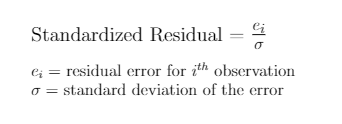Standardized residuals in statistics are the residual or error values obtained in linear regression models which have been standardized by dividing them by the standard deviation of the error.
The residuals in the regression model are obtained by taking the difference of the predicted value and the actual value of the dependent variable.
We know that one of the assumptions in a linear regression model is that the errors are random and are normally distributed with mean 0 and variance σ2. Hence dividing by the standard deviation basically amounts to converting the normal distribution to the standard normal distribution. The residuals get converted to Z scores which are much easier to handle.
How to calculate Standardized Residuals?
Our linear regression model is given as,
Yi = mXi + c + ei
where, the error ei are normally distributed.
The standardized residuals can be calculated using the formula,

Example: In a linear regression model with 5 observations the residuals are obtained as follows,
-1.3,+4.7,-0.4,+0.8 and +1.4 with a standard deviation of 2.
Obtain the standardized residual values.
Solution: We obtain the residual values using the above formula,
1st residual value = -1.3/2 = -0.65
2nd residual value = +4.7/2 = +2.35
3rd residual value = -0.4/2 = -0.2
4th residual value = +0.8/2 = +0.4
5th residual value = +1.4/2 = +0.7
Residual Plot:
We can graph the above residuals to obtain the residual plot. The residual plot is important because by inspecting the residual plot we can decide whether the errors are randomly distributed or not. The residuals are usually not plotted manually. To know how to construct the residual plot using R software click here.